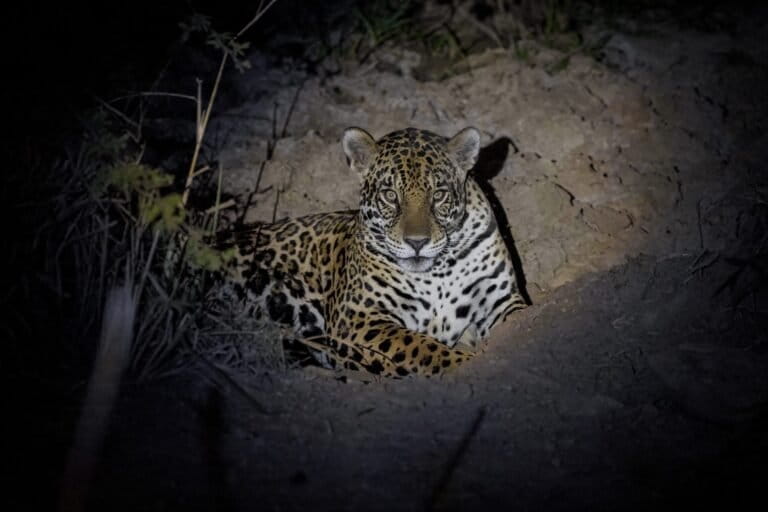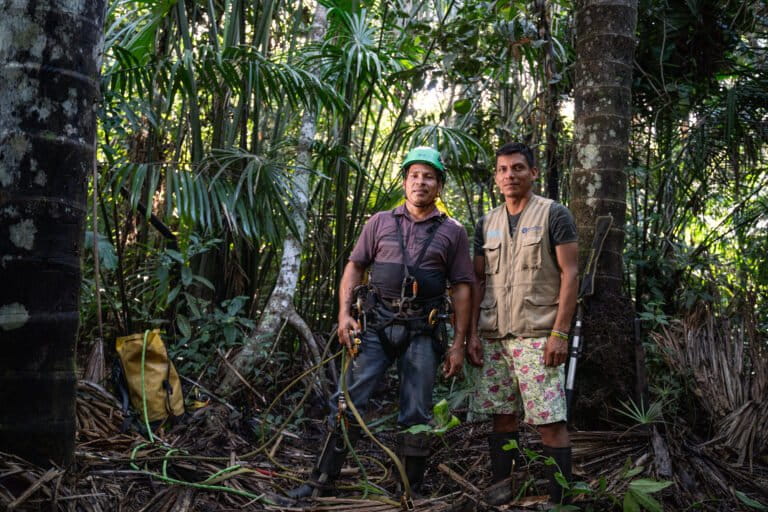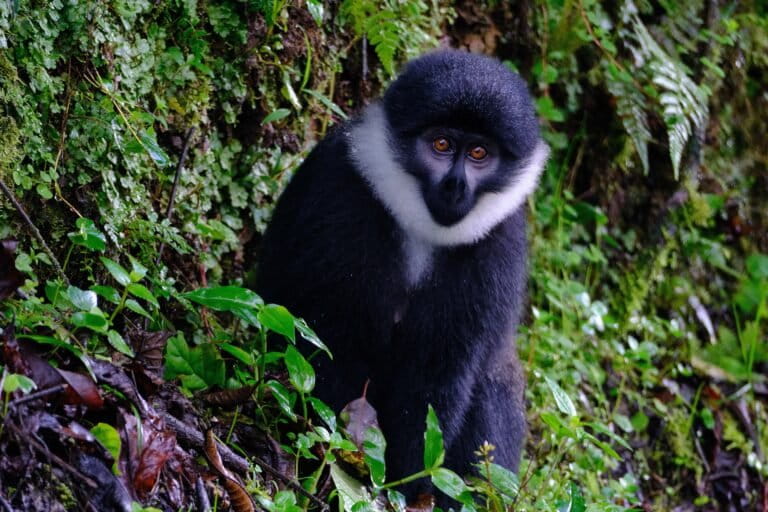- Skywalker hoolock gibbons have been confirmed for the first time in the forests of northeastern Myanmar, with researchers using acoustic monitoring and DNA analysis to identify 44 groups of the imperiled primates.
- The discovery officially extends the range of the endangered species, first described as recently as 2017, beyond the borders of China; the population found in Myanmar is the largest known population of the species on the planet.
- The researchers also conducted a threat analysis, identifying habitat loss from logging and mining and hunting for the illegal wildlife trade as major pressures.
- Given the prevailing political conflict and paucity of well-managed protected areas in Myanmar, local communities and experts recommend scaling up grassroots and Indigenous-led conservation efforts to protect the threatened primates and their forest home.
The morning song of gibbons, with its accelerating, bubbling crescendo, is arguably one of the most enthralling sounds of the tropical forests of Southeast Asia. For many, it’s a sound that signifies the vitality of the forest ecosystem — if there are gibbons, there must be fruit, and therefore likely a plethora of other fruit-eating species. But for primatologists, the gibbon’s song contains telltale clues that help them identify which of the world’s 20 species is about.
This acoustic approach was recently adopted by a team of specialists in Myanmar, resulting in the discovery of previously unknown populations of Skywalker hoolock gibbons (Hoolock tianxing), an incredibly rare species of the small apes only described by scientists as recently as 2017.
The finding, documented in a new study published in the International Journal of Primatology, is first time Skywalker hoolock gibbons have been confirmed in Myanmar, and expands the endangered species’ range beyond the borders of China where a tiny population of fewer than 200 individuals represents the only other known record of the species on Earth.
“This is a very important discovery,” said study co-author Pengfei Fan, a researcher at Sun Yat-Sen University in China. “Considering the very small population in China … Myanmar plays the most important role in conserving this species. I hope resources will be invested to protect [it] and its habitat.”
Fan was among the team of researchers who first described Skywalker hoolock gibbons as distinct from their close relatives, the eastern hoolock gibbon (H. leuconedys), in southwestern China in 2017. Skywalkers are named in part for the Chinese characters in their scientific name, which translate to “heaven’s movement” and also as a nod to the famous film franchise, “Star Wars,” of which the 2017 team are fans.
Since gibbon songs can carry across the forest landscape for more than 1 kilometer (0.6 miles), the Myanmar survey team, led by researchers from Fauna & Flora and Nature Conservation Society Myanmar, listened for gibbons on higher ground, mainly along ridges and hillsides, and deployed triangulation methods to pinpoint the location of groups of gibbon troops and estimate their numbers.
Once they had a gibbon troop within their sight, the researchers took photographs to confirm visual characteristics of the species; Skywalkers typically have thinner eyebrows than other hoolock gibbons, and also sport a black or brown beard, rather than a white one.
The researchers then scoured the ground for chewed remains of fruits and other plants and used a specially designed genetic analysis kit developed by the One Health Institute at the University California, Davis, in the U.S. to identify the gibbons to species level.
Calling and duetting Skywalker hoolock gibbons recorded in Myanmar. Audio courtesy of Fauna & Flora and Nature Conservation Society Myanmar. Image © Fan Pengfei, Sun Yat-Sen University.
A theory is proven
Experts had long believed that the species’ range extended into Myanmar. Given the lithe primates are almost exclusively tree-dwelling, relying on a mode of locomotion called “brachiation” whereby they swing from branch to branch high in the forest canopy, and their lack of ability to swim, gibbon species boundaries are typically demarcated by large watercourses.
It stood to reason that Skywalker hoolock gibbons could conceivably exist within a wedge of contiguous forest extending from their discovery point in southwestern China south into the area between the N’Mai Kha and Irrawaddy rivers in the west, and the Salween River to the east.
Not only do the new findings prove this theory, but the combination of acoustic surveys and DNA testing identified not one, but 44 distinct groups in many parts of the area previously thought to be solely inhabited by eastern hoolock gibbons. With population estimates from 2013 indicating there might have been up to 65,000 gibbons in this area, this part of Myanmar is now likely the most significant stronghold of Skywalker hoolock gibbons on the planet.
The team found them in several locations in Kachin and Shan states in northeastern Myanmar, inhabiting both dense forest and degraded forest at much lower elevations than expected. While their capacity to live in disturbed forest indicates they are highly adaptable, it also sounds the alarm for conservationists who say more needs to be done to ensure their protection and long-term survival.
“While there are now more confirmed groups of Skywalker gibbons in the wild, it is feared that their populations are fast declining due to habitat degradation and loss, and poaching,” said study co-author Ngwe Lwin, the Myanmar country director for Fauna & Flora. “With the new data collected during this study, we hope to continue working with the government and local communities to establish better protection for areas inhabited by gibbons.”
The IUCN, the global wildlife conservation authority, says the species’ habitats of evergreen, scrub, semideciduous and broadleaf hill forests are being destroyed by commercial logging, mining and agricultural expansion. It also cites threats from the illegal wildlife trade, with hoolock gibbons consistently illicitly exported from Myanmar into China. Due to these threats and the fact that more than 90% of the species range is located outside of protected areas, the IUCN classifies the species as endangered.
To gauge local knowledge about the gibbons and the threats they face in Myanmar, the team of researchers interviewed residents of 12 villages near newly discovered Skywalker habitats. They identified habitat loss and degradation, and disturbance due to human conflict as the main pressures on gibbons, only 4% of which live within formally protected areas in the country. Given these pervasive threats, the team recommends the species retain its status of endangered on the IUCN Red List.

Grassroots efforts work
Given the paucity of well-managed protected areas in Myanmar and a lack of state-led capacity to enforce wildlife laws, the study says community forest management is likely to be the most immediate and effective way of safeguarding the gibbons.
Communities in both Kachin and Shan states told the research team they were keen to protect the gibbons through local awareness programs to prevent hunting and community protected areas, which would also help them to prevent land grabs for mining — a prevailing and pervasive threat to rural forested areas in conflict-torn Myanmar.
In all cases, communities cited their preference for Indigenous- and community-led conservation efforts over state-led approaches that have been implicated in human rights and environmental abuses in the country. Moreover, Indigenous-led forest protection has been shown to benefit primate species diversity, both globally and within Myanmar.
Ngwe Lwin said the presence of the gibbons should act as an incentive for everyone to get involved in conservation in Myanmar. “Now more than ever, it is recognised that the collective efforts of stakeholders, including governments, communities and Indigenous Peoples’ groups, are the only effective way to protect and save our closest living relatives.”
Study co-author Susan Cheyne, vice chair of the IUCN Primate Specialist Group Section on Small Apes, told Mongabay the discovery that Skywalker hoolock gibbons appear to be more widespread than previously thought is cause for hope. So long as the government in Myanmar can play its part in effectively and fairly protecting protected areas and communities continue to be engaged in safeguarding the gibbons, she said there’s “a solid base from which to build.”
Banner image: An adult female Skywalker gibbon. Image © Fan Pengfei/Sun Yat-Sen University.
Carolyn Cowan is a staff writer for Mongabay. Follow her on 𝕏, @CarolynCowan11.
Myanmar’s primates and their guardians need more support, study says
Citations:
Aung, P. P., Lwin, N., Aung, T. H., Htike, T. S. M., Thompson, C., Roos, C., … & Evans, T. S. (2024). Confirmation of Skywalker hoolock gibbon (Hoolock tianxing) in Myanmar extends known geographic range of an endangered primate. International Journal of Primatology. doi:10.1007/s10764-024-00418-6
Woods, K. M. (2019). Green territoriality: Conservation as state territorialization in a resource frontier. Human Ecology, 47(2), 217-232. doi:10.1007/s10745-019-0063-x
Torres‐Romero, E. J., Nijman, V., Fernández, D., & Eppley, T. M. (2023). Human‐modified landscapes driving the global primate extinction crisis. Global Change Biology, 29(20), 5775-5787. doi:10.1111/gcb.16902
Thompson, C., Lwin, N., Aung, P. P., Aung, T. H., Htike, T. S. M., San, A. M., … Evans, T. S. (2023). The status of primates and primatology in Myanmar. Global Ecology and Conservation, 47. doi:10.1016/j.gecco.2023.e02662
FEEDBACK: Use this form to send a message to the author of this post. If you want to post a public comment, you can do that at the bottom of the page.














